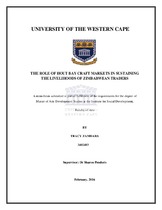| dc.contributor.advisor | Penderis, Sharon | |
| dc.contributor.author | Zambara, Tracy | |
| dc.date.accessioned | 2016-09-23T12:49:01Z | |
| dc.date.available | 2016-09-23T12:49:01Z | |
| dc.date.issued | 2016 | |
| dc.identifier.uri | http://hdl.handle.net/11394/5241 | |
| dc.description | Magister Artium (Social Work) - MA(SW) | en_US |
| dc.description.abstract | During the year 2000 Zimbabwe faced a multiplex of challenges linked to political and economic dynamics generated from its Fast Track Land Reform Programme (Raftopoulos, 2009). The country plunged into land grabs (dubbed Third Chimurenga) led by the war veterans, motivated by economic freedom and emancipation for the black majority. Thus began the economic decline and the exodus of citizens leaving the country in search for employment opportunities and better living conditions abroad. As expressed by Raftopoulos (2009), the problem of economic hardship and perpetual uncertainty worsened in 2008 due to the violent elections that were held in the country which resulted in rampant killings and a hyperinflation that saw the Zimbabwe dollar plunge into trillions. Many families were displaced as people were forced to flee to neighbouring countries including South Africa in search for a better life as well as opportunities. Zimbabweans entered the South African job market which had already begun struggling due to the economic recession experienced in 2008 (Matshaka, 2009). This left many Zimbabweans unemployed and with many survival challenges. In order to survive, many of these refugees started learning creative arts and crafts with the hope of using their skills and capabilities for self-employment. It is within this context that this research investigates the coping mechanisms used by Zimbabwean refugees in combating the challenges of unemployment and poverty by trading through craft markets in Hout Bay as a means of survival and livelihood. The Sustainable Livelihoods Framework (SLF) was used as a theoretical lens through which to examine the livelihood strategies of Zimbabwean refugees as a means of survival. With regard to the selection of research design the mixed methods approach was used to broaden the width and depth of assessment. This included both qualitative and quantitative methods in order to collect data relevant to the research question. | en_US |
| dc.language.iso | en | en_US |
| dc.publisher | University of the Western Cape | en_US |
| dc.subject | Zimbabwean refugees | en_US |
| dc.subject | Sustainable livelihoods | en_US |
| dc.subject | Craft markets | en_US |
| dc.subject | Informal traders | en_US |
| dc.subject | Informal sector | en_US |
| dc.title | The role of Hout Bay craft markets in sustaining the livelihoods of Zimbabwean traders | en_US |
| dc.type | Thesis | en_US |
| dc.rights.holder | University of the Western Cape | en_US |

